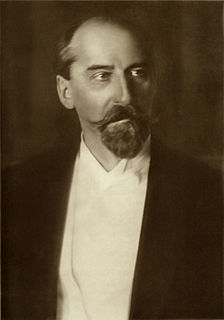
Tallinn is the capital and largest city of Estonia. It is on the northern coast of the country, on the shore of the Gulf of Finland in Harju County. From the 13th century until 1918, the city was known as Reval. Tallinn occupies an area of 159.2 km2 (61.5 sq mi) and has a population of 440,776.

The national flag of Estonia is a tricolour featuring three equal horizontal bands of blue (top), black, and white. The normal size is 105 by 165 centimetres. In Estonian it is colloquially called the "sinimustvalge", after the colors of the bands.

The Estonian Centre Party is a centrist, social-liberal, populist political party in Estonia. It is one of the two largest political parties in Estonia and currently has 26 seats in the Estonian Parliament. The Party is a member of the Alliance of Liberals and Democrats for Europe (ALDE).
Otto August Strandman was an Estonian politician, who served as Prime Minister (1919) and State Elder of Estonia (1929–1931). He was one of the leaders of the centre-left Estonian Labour Party, that saw its biggest support after the 1919 and 1920 elections. Strandman was a key figure in composing the radical land reform law and the 1920 Constitution. He also served as Minister of Agriculture (1918–1919), Minister of Justice, Minister of Finance (1924), Minister of Foreign Affairs and Minister of War (1919). While he was in the office of Minister of Finance, he stabilized the economy and managed to avoid hyperinflation. Strandman was also the speaker of both the Estonian Provincial Assembly (1917–1918) and Riigikogu (1921). He was a diplomat, serving as an envoy in Warsaw (1927–1929), when he made contacts with Polish politicians, and in Paris (1933–1939). During the Soviet Occupation in 1941, Strandman was ordered to show up to the NKVD headquarters. Already knowing about his fate, he committed suicide in his home in Kadrina.

Konstantin Päts was the most influential politician of interwar Estonia, and served five times as the country's head of government. He was one of the first Estonians to become active in politics and started an almost 40-year political rivalry with Jaan Tõnisson, first through journalism with his newspaper Teataja, later through politics. He was condemned to death during the 1905 Revolution, but managed to flee first to Switzerland, then to Finland, where he continued his literary work. He returned to Estonia, but had to spend time in prison in 1910–1911.

Jaan Tõnisson was an Estonian statesman, serving as the Prime Minister of Estonia twice during 1919 to 1920, as State Elder from 1927 to 1928 and in 1933, and as Foreign Minister of Estonia from 1931 to 1932.

The Estonian Internal Security Service is a central national security institution of Republic of Estonia. Its purposes are centered on enforcing constitutional order. The Estonian Internal Security Service has primary investigative jurisdiction in some offences committed by state officials; countering terrorism; incitement to hatred; crimes against humanity and peace, including war crimes; illegal handling and trafficking of firearms, ammunition, explosives, radioactive material or other strategic materials; and the protection of state secrets. It also fills counterintelligence duties.

Parliamentary elections were held in Estonia between 21 and 23 May 1932.
Parliamentary elections were held in Estonia between 15 and 17 May 1926. Before the elections the electoral law was changed to create more stability by introducing a system of bonds and raising the electoral threshold to require a party to win a minimum of two seats.

Parliamentary elections were held in Estonia between 5 and 7 May 1923. There were some controversies - some lists, most remarkably Communist, were declared void before the elections because of electoral law violations, and the results gave Estonia its most fragmented parliament ever.

Parliamentary elections were held in Estonia between 27 and 29 November 1920, the first held under the 1920 constitution. 100 deputies were elected into the new Riigikogu by party lists in 10 regions, by which one party or electoral bloc could put up several lists in one region. Seats were still distributed on the state level, where votes for different lists were summed up by their political affiliation and then seats distributed using d'Hondt formula. Thereafter seats for one party or bloc were distributed between different lists of that political force using the same formula.
Viru Keemia Grupp (VKG) is an Estonian holding group of oil shale industry, power generation, and public utility companies.

The Guard Battalion is specialized battalion directly of the Estonian Defense Forces for ceremonial duties and military police tasks. It is based in Tallinn and specialized in urban warfare. This unit was previously known as the Infantry Training Centre Independent Guard Battalion and was part of the Estonian Ground Forces.

Tarmo Kõuts is an Estonian politician and former Commander of the Estonian Defence Forces.

The Scouts Battalion is a battalion of the Estonian Land Forces. It is a part of the 1st Infantry Brigade and acts as its rapid response unit. The battalion is currently based at Tapa and is commanded by Lieutenant Colonel Tarmo Kundla.

The Tallinn Power Plant is a former power plant located in Tallinn, Estonia. Construction of the power plant was initiated by Volta company and it was decided by the Tallinn City Council in 1912 after the work of special committee established in 1909. The plant was located next to the Tallinn Gas Factory at the location of the former Stuart fortress. The plant was designed by Volta and the architect was Hans Schmidt. Originally it used three Laval-type 250 horsepower (0.19 MW) steam turbines and three 250 horsepower (0.19 MW) electric generators—all produced by Volta. Two coal-fired boilers were manufactured by AS Franz Krull. The power plant was opened on 24 March 1913 and originally it was fired by coal. In 1919–1920 the plant was expanded and transferred to peat and wood. In 1924 the power plant was switched to oil shale. It was the first power plant in the world to employ oil shale as its primary fuel. In 1939, the plant achieved capacity of 22 MW.
National Institute of Chemical Physics and Biophysics is public non-profit research institute that carries out fundamental and applied research and engages in the development of the novel directions in material sciences, physics, chemistry, gene- and biotechnology, environmental technology, and computer science. in Estonia, Tallinn at the address Akadeemia tee 23.

Esimene Eesti Põlevkivitööstus was an oil shale company located in Kohtla-Järve, Estonia. It was a predecessor of Viru Keemia Grupp, a shale oil extraction company.
The Estonian Riigikogu, or Parliament, is made up of 101 members, elected from 12 separate geographic areas, or electoral districts. The constituency division is based on the counties of Estonia, of which some are combined or divided depending on the size of the population. The capital city Tallinn is divided into three electoral districts based on administrative districts within the city. In the elections to the European Parliament, Estonia has only one national electoral district.

Vassili Grigorjev was a Russian-Estonian farmer and politician.












